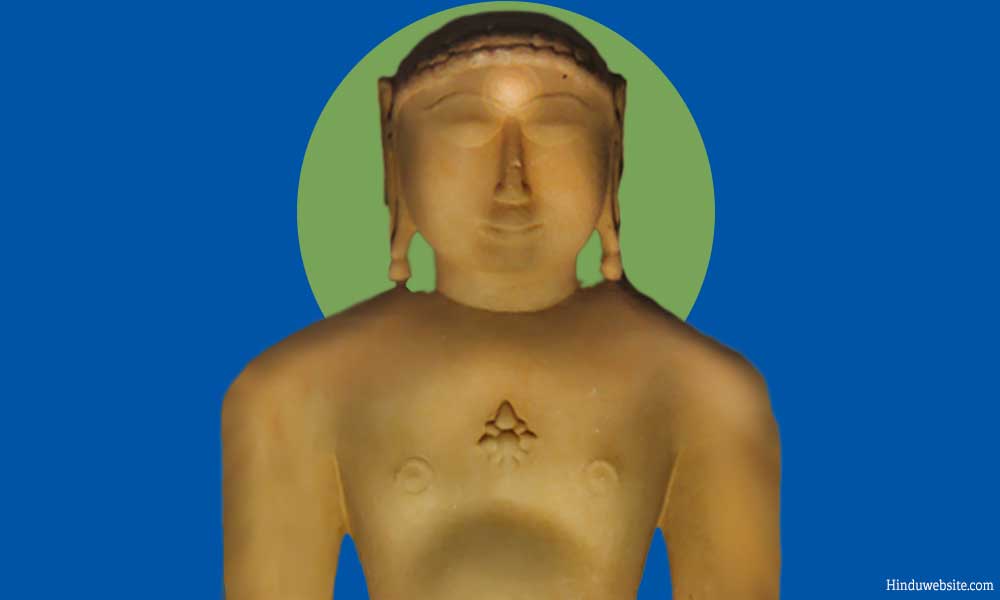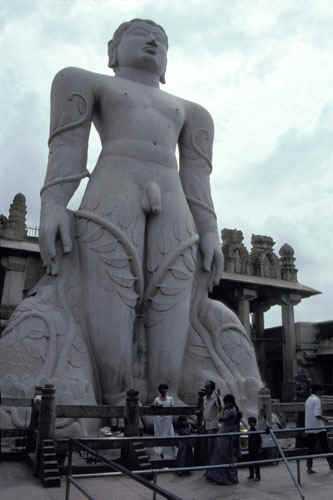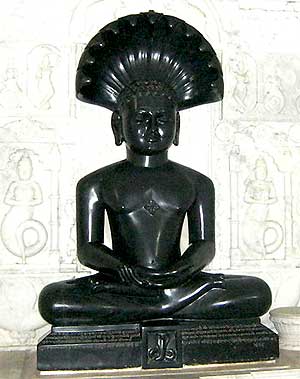
An Introduction to Jainism or Jain Dharma

Jainism, traditionally known as Jain Dharma, is one of the most ancient religious traditions of the Indian subcontinent with its origin rooted in prehistoric times. Although it is now reduced to a minority religion in India and elsewhere, there was a time when it dominated most parts of India and enjoyed patronage from some of the most prominent rulers of ancient India. Chandragupta Maurya, the first well known emperor of India, became a follower of Jainism in the last phase of his reign and ended his life by fasting in the true tradition of a Jain monk.
Although it yielded place to Brahmanism and Buddhism, it left an indelible impression on the canvass of Indian religious life. There is no exaggeration in saying that it was not Buddhism but Jainism which lives in the core of Hinduism in the form of some vital concepts and practices that are too difficult to ignore. According to Jain beliefs, its doctrine is ancient and eternal. It is passed on to humanity in each time cycle and becomes lost over a period of time. It reappears again through the teachings of purified and enlightened beings known as thirthankaras.
According to Jain tradition, the first to come upon earth in this time cycle to reintroduce the ancient dharma was Rishabhanatha also known as Adinatha, the first in the line of 24 thirthankaras who were destined to manifest upon earth. Parshvanatha (877-777 BC) and Vardhaman Mahavira were the two in the succession. Jainism played a significant role in the religious tradition of India. Perhaps there is no other tradition in the country that left its impression so much as Jainism upon the religious way of life which we now distinguish as the Sanatana Dharma or more popularly Hinduism. Jainism stresses the spiritual independence and equality of all life with a particular emphasis on non-violence, which is now an essential component of Hindusim. Self-control (vrata) and vigorous asceticism are the means by which Jains attain moksha or liberation from the cycle of rebirth. It is in the rigors of the practice and the degree of seriousness with which the ideals of asceticism are followed where Jainism stands apart from both Hinduism and Buddhism.
Souls
According to Jainism the destiny of every being is a consequence of its actions. Souls are unborn and uncreated. They are also eternal and equal. They exist in both animate and inanimate objects of existence. They all are capable of become free or attaining Moksha, through their personal efforts. The liberation of each soul depends upon its own karma and purity of effort. There is no such thing as divine intervention or grace of a guru. Jains venerate Tirthankaras as a mark of gratitude for the teachings left by them. they are are pure beings, who manifest upon earth from time to time according to an established pattern to teach people the doctrine of liberation and show them the way through their own example. Jainism views the whole existence as sacred, since it is infused with innumerable souls, some bound and some liberated. We should therefore, think and act responsibly towards all existence. The pure soul of each living being is looked upon as Infinite Knowledge, Perception, Consciousness, and Happiness (Ananta Jnana, Ananta Darshana, Ananta Caritra, and Ananta Sukha). In Jainism there is no place for an omnipotent Supreme Being, Creator or Doer, but rather in an eternal universe governed by natural laws and inhabited by innumerable souls in varying degrees of bondage and libeation.
Thirthankaras
One of the distinguishing features of Jainism is the concept of Tirthankaras or pure beings who have crossed the world of bondage to the other side of eternal freedom. A thirthankara is not a god but a pure soul who shows the way to liberation. The 24 tirthankaras in chronological order are - Adinath (or Rishabhnath), Ajitanath, Sambhavanath, Abhinandananath, Sumatinath, Padmaprabh, Suparshvanath, Chandraprabhu, Pushpadantanath (or Suvidhinath), Sheetalanath, Shreyansanath, Vasupujya, Vimalanath, Anantanath, Dharmanath, Shantinath, Kunthunath, Aranath, Mallinath, Munisuvratanath, Neminath, Arishthanemi, Parshvanath and Mahavir (or Vardhamana).

Ahimsa
Compassion to all fellow living beings (along with humans) is central to Jain belief. Jainism is the only religion wherein all followers, both monks and practicing lay persons of all sects and traditions, are required to be vegetarian. In regions of India with strong Jain influence, often the majority of the population is vegetarian. In many towns, the Jains run animal shelters. In Delhi, there is a bird hospital run by a Jain temple. Many historians believe that various strains of Hinduism adopted vegetarianism due to the strong influence of Jainism and Buddhism.
Jains cover their mouths to prevent the possibility of inhaling insects and small organisms, a practice associated with their belief in non-violence and the possibility of unintentional bad karma. As a part of its stance on nonviolence, Jainism goes even step beyond vegetarianism, in that the Jain diet also excludes most root vegetables, as Jains believe such vegetables have an infinite number of individual souls, invisible to the naked eye. Jains also do not eat certain other foods believed to be unnecessarily injurious. Many Jains are also vegan, due to the cruelty, and violence inherent in modern dairy farms. Observant Jains do not eat, drink, or travel after sunset, and always rise before sunrise.
History suggests that various strains of Hinduism became vegetarian due to strong Jain influences. Jains run animal shelters all over India. For example, Delhi has a bird hospital run by Jains. Every city and town in Bundelkhand has animal shelters run by Jains where all manner of animals are sheltered, even though the shelter is generally known as a Gaushala.
Existential Suffering
Jains hold that this temporal world is full of miseries and sorrow and hence in order to attain lasting bliss one must transcend the cycle of transmigration. Otherwise, one will remain eternally caught up in the never-ending cycle of transmigration. The only way to break out of this cycle is to practice detachment through rational perception, rational knowledge and rational conduct.
Karma
The Jain religion places great emphasis on Karma. Essentially, it means that all jivas reap what they sow. A happy or miserable existence is influenced by actions in previous births. These results may not occur in the same life, and what we sow is not limited to physical actions. Physical, verbal, and mental activities affect future situations. Karma has long been an essential component of Jainism, and other Indian religions such as Buddhism, Hinduism and Sikhism. It is believed generally that an omniscient Tirthankar can foresee all things, long before science.
Tattvas
The backbone of the Jain philosophy are seven fundamental concepts (Tattvas). Please note that some Jain commentators include two more additional concepts to the following seven namely merit (punya) and demerit (papa) karmas. Without knowing these seven basic concepts, one cannot progress towards liberation. They are:
Jiva - Souls and living things
Ajiva - Non-living things
Asrava - Influx of karma
Bandha - The bondage of karma
Samvara - The stoppage of influx of karma
Nirjara - Shedding of karma
Moksha - Liberation or Salvation
A simple example: A man rides a wooden boat to reach the other side of the river. The man is Jiva, the boat is ajiva. Now the boat has a leak and water flows in. That incoming of water is Asrava and accumulating there is Bandha. When this man tries to save the boat by blocking the hole, that blockage is Samvara and throwing the water outside is Nirjara. Moksha is when this man crosses the river and reaches his destination.
Jain Fasting
Fasting is common among Jains and a part of Jain festivals. Most Jains fast at special times, during festivals, and on holy days. Pajushan is the most prominent festival, lasting eight days in Svetambara Jain tradition and ten days in Digambar Jain tradition during the monsoon. The monsoon is a time of fasting. However, a Jain may fast at any time, especially if he or she feels some error has been committed. Variations in fasts encourage Jains to do whatever they can to maintain self control
Some Jains revere a special practice, where a person who is aware that he or she may die soon, and feels he has completed all his duties, ceases to eat or drink until death. This form of dying is called santhara. It is considered to be extremely spiritual and creditable. This has recently led to a controversy in India, where in Rajasthan, a lawyer petitioned the High Court of Rajasthan to declare Sallekhana illegal. Jains see Sallekhana as spiritual detachment. It is a declaration that a person has finished with living in this world and now chooses to leave.
Jain worship and rituals

Every day most Jains bow and say their universal prayer, the Namokara Mantra, aka the Navkar Mantra. Jains have built temples, or Basadi or Derasar, where images of Tirthankars are worshiped. Jain rituals may be elaborate because symbolic objects are offered and Tirthankaras praised in song. But some Jain sects refuse to enter temples or worship images. All Jains accept that images of Tirthankaras are merely symbolic reminders of the path that they have to take, in order to attain moksha. Jains are clear that the Jinas reside in moksha and are completely detached from the world. Jain rituals include: Pancakalyanaka Pratishtha, Pratikramana, Samayika, Guru-Vandana, Chaitya Vandana, and other sutras to honor ascetics.
Anekantavada
Anekantavada is one of the foundation pillars of Jain philosophy. Literally meaning "Non-one-endedness" or "Nonsingular Conclusivity", Anekantavada is a set of tools for overcoming the inherent bias in any one perspective on a given subject, object, process, state, or reality in general. One of these tools is known as The Doctrine of Postulation, i.e., Syadvada. Anekantavada is also define as multiplicity of views, and stresses looking at things from the other person's perspective.
Creation and cosmology
According to Jain beliefs, the universe was never created, nor will it ever cease to exist. Therefore, history of the universe is shaswat (infinite). It has no beginning or end, but time is cyclical in nature with progressive and regressive spirituality phases. In other words Jains divide time into Utsarpinis (Progressive Time Cycle) and Avsarpinis (Regressive Time Cycle). An Utsarpini and a Avsarpini constitute one Time Cycle (Kalchakra). Every Utsarpini and Avsarpini is divided into six unequal periods known as Aras. During the Utsarpini half cycle, humanity develops from its worst to its best: ethics, progress, happiness, strength, health, and religion each start the cycle at their worst, before eventually completing the cycle at their best and starting the process again. During the Avsarpini half-cycle, these notions deteriorate from the best to the worst. Jains believe we are currently in the fifth Ara of the Avsarpini phase, with approximately 19,000 years until the next Ara. After this Avsarpini phase, the Utsarpini phase will begin, continuing the infinite repetition of the Kalchakra.
Jains also believe that at the upswing of each time cycle, people will lose religion again. All things people want will be given by wish-granting trees (Kalpavrksa), and people will be born in sets of twins (Yugalika) with one boy and one girl who stay together all their lives. This can be seen as a symbol of an integrated human with male and female characteristics balanced.
Jain philosophy is based upon eternal, universal truths, according to its followers. During the first and last two Aras, these truths lapse among humanity and then reappear through the teachings of enlightened humans, those who have reached enlightenment or total knowledge (Kevala Jnana), during the third and fourth Aras. Traditionally, in our universe and in our time, Lord Rishabha is regarded as the first to realize the truth. Lord Vardhamana Mahavira, was the last Tirthankara to attain enlightenment (599-527 BCE), who was himself preceded by twenty-three other Tirthankaras, thus making a total of twenty-four Tirthankaras.
It is important to note that the above description stands true "in our universe and in our time" for Jains believe there have been infinite sets of 24 Tirthankaras, one for each half of the time cycle, and this will continue in the future. Hence, Jainism does not trace its origins to Rishabh Deva, the first, or Mahavira, the twenty-fourth, Tirthankara.
According to Jainism, the Universe consists of Infinite amount of Jiva'(life force or souls), and the design is similar to a form of a man standing with his arms bent while resting his hands at his waist. The narrow waist part comprises various 'Kshetras' which act as place of 'vicharan' (roaming) for humans, animals and plants. Currently we are in the Bharat Kshetra of 'Jambu Dweep' (dweep meaning Island) .
The Deva' Loka (Heavens) are situated at the symbolic chest part of the Creation, where all the Devas (demi gods) reside. Similarly beneath the waist part are the Narka Loka (Hell). There are such Seven Narka Lokas, each for a varying degree suffering a jiva' has to go through to face the consequences of its papa' karma (sins). From the first to the seventh Narka, the degree of suffering increases and the amount of Light reaching into it decreases (no light at all in the seventh Narka).
The sidhha kshetra or moksha is situated at the symbolic forehead of the creation, where all the jivas having attained nirvana reside in a state of complete peace and eternal happiness. Outside the symbolic figure of this creation nothing but aloka or akaasha (sky) exists.
The Religious Tolerance of Jains
Jains can be remarkably welcoming and friendly toward other faiths. For example, several non-Jain temples in India are administered by Jain individuals. The Jain Heggade family has run the institutions of Dharmasthala including the Sri.Manjunatha Temple for eight centuries. There are examples of Jains donating money for building churches and mosques. In India, Jains have often helped organize multi-religious discussions and functions, and Jain monastic leaders such as the late Acharya Tulsi and Acharya Sushil Kumar, have also promoted harmony among followers of rival faiths to help defuse communal tensions.
Jains have been an important presence in Indian culture, contributing to Indian philosophy, art, architecture, sciences, and the politics of Mohandas Gandhi, which led to Indian independence.
Suggestions for Further Reading
- The Atomic Theory of Jainism
- History of Jainism
- Jainism - Philosophy and Doctrine
- Major Beliefs of Jainism
- Jain Literature and Canonical Texts
- Jainism Cosmology
- The Jains And Their Creed
- Jainism - Doctrine and History
- An Introduction to Jainism or Jain Dharma
- The Philosophy and Practice of Jainism
- Information Websites on Jainism
- Jainism and the Belief in God
- Jainism - Jivas, the Embodied Souls
- Jainism - Belief in Karma
- The Theory of Knowledge in Jainism
- History of Jainism after Mahavira
- Vardhamana Mahavira
- Jainism - Anekantavada or Nayavada
- An Outsider Perspective on Jainism
- Jainism - Sects and Subsects
- Syadavada or Saptabhangi
- The Tattvas of Jainism
- Jain Thirthankaras
- Ethics of Jainism - The Three Jewels
- Tirthahkaras Before Mahavira
- Essays On Dharma
- Esoteric Mystic Hinduism
- Introduction to Hinduism
- Hindu Way of Life
- Essays On Karma
- Hindu Rites and Rituals
- The Origin of The Sanskrit Language
- Symbolism in Hinduism
- Essays on The Upanishads
- Concepts of Hinduism
- Essays on Atman
- Hindu Festivals
- Spiritual Practice
- Right Living
- Yoga of Sorrow
- Happiness
- Mental Health
- Concepts of Buddhism
- General Essays
Source: Adapted with suitable modifications and improvements from Wikipedia article on Jainism under the TGNU Free Documentation License